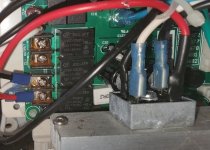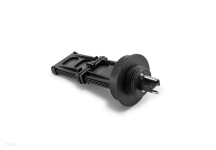A "Low Salt" error causes Intex SWGs to shut down, and refuse to make chlorine.
Mine gave me 3 such errors on successive nights.
There are multiple videos purporting to "fix" the issue, by hot-wiring the metal-plate cell directly to the transformer, and bypassing the timer and all the "intelligence" of the device.
But I like the idea of the timer and the water-flow detector, and the other controls and features.
So, what about actually diagnosing and fixing the issue? Assuming that one has already inspected and cleaned the cell if required, one can easily notice that initially, the clear piping allows one to see the bubbles of gas being created by the cell in the initial period before the "Low Salt" alarm, so the cell is plainly "working".
So, what's wrong? The alarm is due to a decreased conductivity (increased resistance) in the water between the plates of the cell. Its just an ohm-meter.
[EDIT 8/14/2021]
I was sloppy in the original post about salt and conductivity/resistance, speculating that perhaps excessive backwashing might result in a physical "low salt" condition. WRONG!
My little 4545 gallon pool is supposed to need 117 lbs of salt, and salt comes in 40-lb bags, so I had a few extra pounds of salt to toss in, and if this guess is wrong, the equipment will be just as happy with 120lbs as with 117lbs, only 2% difference. But that didn't fix the issue, and the idea is a somewhat silly one to begin with, as fresh water by its nature has very few ions. De-ionized water as a conductivity of about 5.5μS/m.
Sea water has Sodium and Chloride ions and has a conductivity of around 5S/m, as compared with the 5.5μS/m for fresh. So sea water is roughly one million times more conductive than fresh water.
One is going to be hard pressed to screw up the salt if one simply puts in the suggested number of pounds of salt for the gallons of water in the pool, and accounts for only a MAJOR draining of the pool for repairs (like more than 20% of total water volume). I can't see mere backwashing bringing the salt level down significantly, and the "test strips for salt" are an ABSOLUTE JOKE AND ARE NOT TO BE TRUSTED FOR ANY PURPOSE. If you worry about salt, go to a pool store with a real test set for salt in water.
[END EDIT]
So, the obvious answer is corrosion on the electrical connections, and sure enough, I found corrosion everywhere in this circuit.
The connector to the cell was corroded inside the connector, and on one of the posts on the cell itself, so emery paper time.
Here is a very good set of photos on doing this:
 www.inyopools.com
www.inyopools.com
But wait, there's more... inside the case.
Unscrewing the two screws that hold all the plumbing in place, removing the electronics unit from the pipes, and opening it up, there was also quite a bit of corrosion on the terminal block and wires that (no surprise) go to the cell.
I replaced the screws, crimped and soldered on new wire lugs onto the wires, and replaced the corroded metal plates on the two wires with parts salvaged from another terminal strip in my junkbox of salvageable parts, but you can easily buy these. One can sand off the lugs and metal plates, and match the screws at the hardware store. You want stainless steel screws.
The comical thing is that the various YouTube videos documenting the "hot-wiring" bypass of all the electronics show the corrosion very clearly, for example this screenshot:

Note that ALL the terminals are corroded pretty seriously here, but the two "CL -" and "CL+" terminals, from which wires have been removed in the screenshot above, are the exact cause of the error.
Note that other connections in the system (for example, the push-on terminals at bottom right) are NOT corroded in the least, so the problem is simply that a terminal block made of pure Chineseum, (i.e. crappy Zinc metal alloy) is not a good match for electrical connections involving salt water and electricity. As a general rule, you will see white residue if only a zinc coating is being corroded, and red when the underlying steel is corroded. Good-quality stainless steel will resist corrosion, as the chromium added to the steel forms a "passive oxide layer" on the surface of the steel, and if the steel is scratched, more oxide quickly forms in or over the scratch.
So, my $100 SWG (bought on sale as an "open box return") is back to quietly making all the chlorine my little pool needs, without any complaints.
Mine gave me 3 such errors on successive nights.
There are multiple videos purporting to "fix" the issue, by hot-wiring the metal-plate cell directly to the transformer, and bypassing the timer and all the "intelligence" of the device.
But I like the idea of the timer and the water-flow detector, and the other controls and features.
So, what about actually diagnosing and fixing the issue? Assuming that one has already inspected and cleaned the cell if required, one can easily notice that initially, the clear piping allows one to see the bubbles of gas being created by the cell in the initial period before the "Low Salt" alarm, so the cell is plainly "working".
So, what's wrong? The alarm is due to a decreased conductivity (increased resistance) in the water between the plates of the cell. Its just an ohm-meter.
[EDIT 8/14/2021]
I was sloppy in the original post about salt and conductivity/resistance, speculating that perhaps excessive backwashing might result in a physical "low salt" condition. WRONG!
My little 4545 gallon pool is supposed to need 117 lbs of salt, and salt comes in 40-lb bags, so I had a few extra pounds of salt to toss in, and if this guess is wrong, the equipment will be just as happy with 120lbs as with 117lbs, only 2% difference. But that didn't fix the issue, and the idea is a somewhat silly one to begin with, as fresh water by its nature has very few ions. De-ionized water as a conductivity of about 5.5μS/m.
Sea water has Sodium and Chloride ions and has a conductivity of around 5S/m, as compared with the 5.5μS/m for fresh. So sea water is roughly one million times more conductive than fresh water.
One is going to be hard pressed to screw up the salt if one simply puts in the suggested number of pounds of salt for the gallons of water in the pool, and accounts for only a MAJOR draining of the pool for repairs (like more than 20% of total water volume). I can't see mere backwashing bringing the salt level down significantly, and the "test strips for salt" are an ABSOLUTE JOKE AND ARE NOT TO BE TRUSTED FOR ANY PURPOSE. If you worry about salt, go to a pool store with a real test set for salt in water.
[END EDIT]
So, the obvious answer is corrosion on the electrical connections, and sure enough, I found corrosion everywhere in this circuit.
The connector to the cell was corroded inside the connector, and on one of the posts on the cell itself, so emery paper time.
Here is a very good set of photos on doing this:
How To Clean a Corroded Salt Chlorine Generator Cord Head - INYOPools.com
This guide shows how to clean the Compupool Salt Chlorine Generator cord head and make it fit snugly to the cell.
But wait, there's more... inside the case.
Unscrewing the two screws that hold all the plumbing in place, removing the electronics unit from the pipes, and opening it up, there was also quite a bit of corrosion on the terminal block and wires that (no surprise) go to the cell.
I replaced the screws, crimped and soldered on new wire lugs onto the wires, and replaced the corroded metal plates on the two wires with parts salvaged from another terminal strip in my junkbox of salvageable parts, but you can easily buy these. One can sand off the lugs and metal plates, and match the screws at the hardware store. You want stainless steel screws.
The comical thing is that the various YouTube videos documenting the "hot-wiring" bypass of all the electronics show the corrosion very clearly, for example this screenshot:

Note that ALL the terminals are corroded pretty seriously here, but the two "CL -" and "CL+" terminals, from which wires have been removed in the screenshot above, are the exact cause of the error.
Note that other connections in the system (for example, the push-on terminals at bottom right) are NOT corroded in the least, so the problem is simply that a terminal block made of pure Chineseum, (i.e. crappy Zinc metal alloy) is not a good match for electrical connections involving salt water and electricity. As a general rule, you will see white residue if only a zinc coating is being corroded, and red when the underlying steel is corroded. Good-quality stainless steel will resist corrosion, as the chromium added to the steel forms a "passive oxide layer" on the surface of the steel, and if the steel is scratched, more oxide quickly forms in or over the scratch.
So, my $100 SWG (bought on sale as an "open box return") is back to quietly making all the chlorine my little pool needs, without any complaints.
Last edited:




